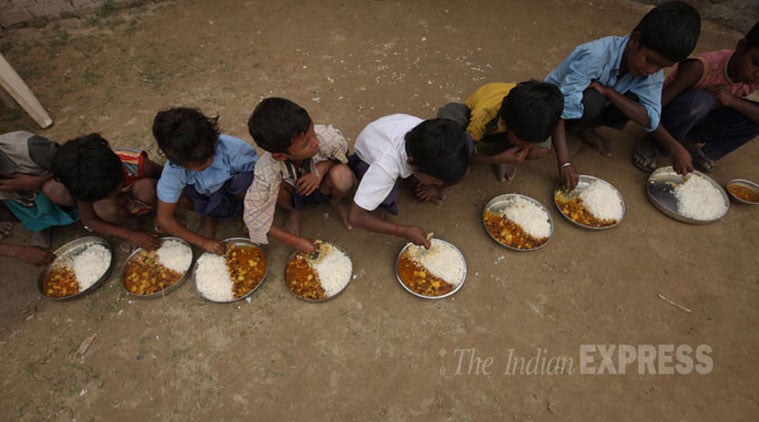
Will drastic cuts in child health, nutrition outlays really be made up by states?
Written by Neerja Chowdhury | Published on:March 30, 2015 12:45 am
The most important priority for any government in India today should be the health and nutrition of its children. This is a matter of emergency. In many ways, it is more important than even education. Why then has an otherwise sensitive finance minister slashed the budget in the health and nutrition sectors so badly?
The budgetary allocations on health and nutrition programmes for children, who are the most vulnerable, have dipped to Rs 11,093 crore from Rs 21,668 crore last year. In December 2014 itself, the finance minister reduced the health budget by 18 per cent, thereby lowering the base for future allocations. This year, he increased allocations by 2 per cent, but on the revised estimates. This adds up to a 16 per cent cut on last year’s outlays.
The Integrated Child Development Services, the world’s biggest social programme, in existence since 1975, which caters to the needs of women and young children, providing midday meals, take-home rations, counselling for mothers and so on — there had been a growing feeling in recent years that it needed to be expanded and made more effective — is down to less than half its size. It has been administered a cut from Rs 18,195 crore to Rs 8,335 crore.
Will there now be no second worker in anganwadis, as had been proposed earlier, to make the programme more effective? Or will existing anganwadi workers be laid off? Or will complementary foods, so critical for children in the first two years of life, be reduced or removed altogether?
In India, almost every second child is malnourished. The damage is done in the first two years of life and is irreversible. You can do what you like afterwards but it will be an uphill struggle to rectify the situation. You don’t need rocket science to address child malnutrition, which leads to the stunting and wasting of children. If unaddressed, it makes children more vulnerable to physical disability, mental challenges and cognitive handicaps — if they survive. In the long run, this lowers the GDP by 2-3 per cent. Children who are severely and acutely malnourished — eight million in the country — can just disappear, their life cut short because of one bout of diarrhoea.
I once asked an expert why the malnourishment figures in India were worse than in sub-Saharan Africa. The answer was shocking, though not surprising: “Because of the large number of underweight mothers in India”. The problem of underweight mothers has everything to do with women’s health, education, their lack of status and empowerment, and early marriages. Every second girl in India under 18 was married, according to the 2006 National Family Health Survey III.
It is linked to widespread anaemia — 55 per cent of women and almost 79 per cent of children under three years of age suffer from it, leaving them listless, unwilling, and unable, to do much. It is also linked to girls’ education, even though investment here yields what has been found to be the “single highest return on investment in the developing world”. For reasons that are obvious — an educated girl is less likely to opt for early marriage, early childbearing or a big family and more likely to make intelligent contraceptive choices. But the family welfare budget, which was low anyway, will now be lower. The education outlays in this year’s budget have also taken a hit — despite the prime minister’s “beti bachao, beti padhao” call.
Finance Minister Arun Jaitley and his deputy, Jayant Sinha, have explained that the states, whose share of Central taxes has increased from 32 to 42 per cent, will now be able to pick up some of the tabs and compensate for the reduction in the Centre’s share from 68 to 58 per cent, which adds up to a decrease of 14.7 per cent. But the cuts in the health and nutrition programmes for children show a decrease of almost 49 per cent; the ICDS has been downsized by as much as 54 per cent.
Let us be honest. Do we really believe that these drastic cuts will be made up for by the states? If the Centre is stepping back, why would the states not do likewise, giving preference to industrial corridors and infrastructural outlays at the cost of the more basic and immediate health needs, which may determine whether many of our children live? So much for the demographic dividend we proudly tout. So much for the pre-poll promises made by the BJP in its manifesto. And so much for promises, made over the years by parties, that they would raise the health outlay to 2.5-3 per cent of the GDP, as is the case in other countries. For the last decade, we have been stuck at the shocking — and shameful — figure of around 1 per cent. But the Opposition chose not to make a “hungama” over this in Parliament.
The government may want to cut sloth and wastage in programmes. But surely that cannot justify its retreat from so vital an area, which affects the right to life itself? It shows that the priority of the NDA government is infrastructure, not the social sector.

